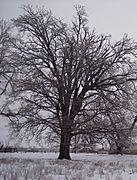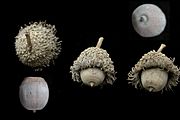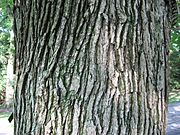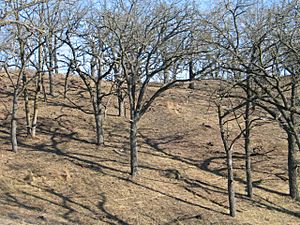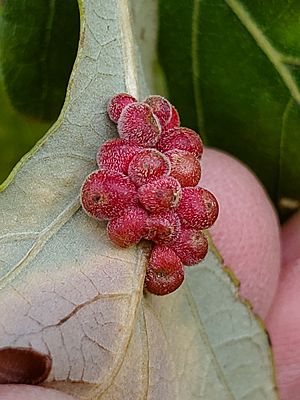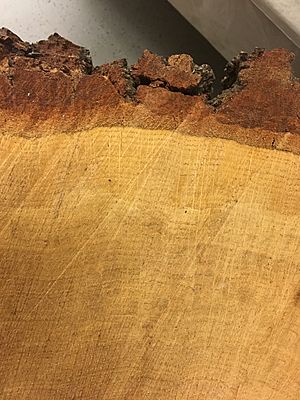Bur oak facts for kids
Quick facts for kids Bur oak |
|
|---|---|
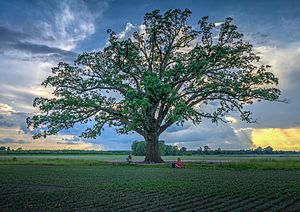 |
|
| A 400-year old tree in Missouri known as The Big Tree | |
| Conservation status | |
| Scientific classification | |
| Genus: |
Quercus
|
| Species: |
macrocarpa
|
 |
|
| Where the bur oak naturally grows | |
| Synonyms | |
|
List
Quercus macrocarpus Michx.
Cerris macrocarpa (Michx.) Raf. Cerris oliviformis (F.Michx.) Raf. Quercus macrocarpa var. abbreviata A.DC. Quercus macrocarpa var. alata Coleman Quercus macrocarpa f. appressa Trel. Quercus macrocarpa var. minor A.DC. Quercus macrocarpa f. olivaeformis (F. Michx.) A. Gray Quercus macrocarpa f. oliviformis (F.Michx.) Trel. Quercus macrocarpa var. oliviformis (F.Michx.) A.Gray Quercus macrocarpa subsp. oliviformis (F.Michx.) A.Camus Quercus macrocarpa f. orbiculata Trel. Quercus oliviformis F.Michx. Quercus olivaeformis F.Michx. Quercus macrocarpa subsp. eumacrocarpa (Michx.) A. Camus |
|
The bur oak, also spelled burr oak, is a type of oak tree. Its scientific name is Quercus macrocarpa. It grows naturally in eastern North America. It is part of the white oak group. People also call it the mossycup oak or blue oak.
The bur oak has the largest acorns of any oak tree in North America. The name macrocarpa comes from Ancient Greek words meaning "large fruit." These big acorns are an important food source for many wild animals.
Contents
What Does a Bur Oak Look Like?
The bur oak is a very large deciduous tree. This means it loses its leaves every fall. It can grow up to 30 meters (about 100 feet) tall. Some rare ones can even reach 50 meters (about 165 feet)! Its trunk can be as wide as 3 meters (10 feet).
Bur oaks grow slowly, about 30 centimeters (1 foot) per year when they are young. A 20-year-old tree can be about 6 meters (20 feet) tall if it gets lots of sun. These trees can live for a very long time, often 200 to 300 years, and sometimes even 400 years!
Leaves, Flowers, and Acorns
The leaves of the bur oak are about 7 to 15 centimeters (3 to 6 inches) long. They are also 5 to 13 centimeters (2 to 5 inches) wide. Their shape can vary, but usually, the bottom part is narrower and has deep lobes. The top part is wider with shallow lobes or large teeth. In the fall, their leaves usually don't turn bright colors, but sometimes they can be a nice golden color.
In the spring, the tree grows greenish-yellow catkins, which are its flowers. The acorns are very big, about 2.5 to 5 centimeters (1 to 2 inches) long. They are 2 to 4 centimeters (0.8 to 1.6 inches) wide. The acorn cup is large and covers most of the nut. It has big, overlapping scales and often a fringe around its edge.
Its Bark
The bark of the bur oak is gray. It has clear ridges that run up and down the trunk.
Where Bur Oaks Grow
The bur oak grows across a large area in North America. You can find it from New Brunswick in Canada down to North Carolina in the United States. It stretches west to Alberta, Montana, Wyoming, and New Mexico. Most bur oaks are found in the eastern Great Plains, the Mississippi–Missouri–Ohio Valley areas, and the Great Lakes region.
Bur oaks like to grow in places with a temperate climate. They often grow in open areas, not in very dense forests. This is why they are common in the eastern prairies, especially near waterways where there are breaks in the tree cover.
Surviving Dry Times and Fires
This tree can handle drought (very dry weather). This is probably because it has a long taproot that goes deep into the ground to find water. A young bur oak, just one year old, can have a taproot over 1.3 meters (4.5 feet) deep!
Older bur oaks (more than 12 years old) can survive fires because their bark is very thick. One common place where bur oaks grow is in an oak savanna. These are areas where fires often happened in early spring or late fall. If there are no fires, other trees and shrubs that like shade might grow and take over from the bur oak.
Animals and Insects That Use Bur Oaks
The large acorns of the bur oak are a very important food for many wild animals. Black bears sometimes even break off branches to get to the acorns! However, the tree only produces a lot of acorns every few years. This is a special strategy called masting. By producing a huge amount of seeds all at once, the tree makes sure that there are too many for animals to eat them all, so some seeds will survive and grow.
Other animals like deer and porcupines eat the leaves, twigs, and bark of the bur oak. Even cattle will eat parts of the tree in some areas.
Many tiny insects, like wasps and mites, create bumps called galls on the leaves and twigs of the bur oak. These galls are like little homes for the insects.
Tree Diseases
Bur oak trees can get a disease called Bur oak blight. This disease is caused by a fungus. It creates black spots on the leaf stems and makes the leaves change color and die. This can make the tree weaker and more likely to get other problems, like root rot or attacks from certain beetles.
Growing Bur Oaks
Nurseries grow bur oak trees to be planted in gardens, parks, and along city streets. Among white oaks, the bur oak is one of the best at handling city conditions. It is also one of the fastest-growing white oaks. It can grow in many different climates and can handle dry weather well.
How People Use Bur Oaks
The wood from the bur oak is very useful. It is strong and lasts a long time. People use it for flooring, fence posts, cabinets, and even barrels.
The acorns from the bur oak can be eaten. You can boil them or eat them raw. Native American people used the bark of the bur oak to help treat wounds, sores, rashes, and diarrhea.
Bur Oaks in Culture
Many places are named after the burr oak. For example, there's Burr Oak State Park in Ohio. There are also cities called Burr Oak, Iowa and Burr Oak, Kansas, and a village named Burr Oak, Michigan. A book of poems called Burr Oaks was written by Richard Eberhart in 1947.
See also
 In Spanish: Roble bur para niños
In Spanish: Roble bur para niños



